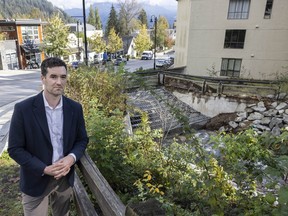The District of North Vancouver’s initial response includes assessing its storm-drain systems and making sure anything damaged will still allow water to pass through in the event of another storm.

Article content
Insurance executive Aaron Sutherland lives in Deep Cove, and during last weekend’s deluge that dumped more than 300 millimetres of rain on North Vancouver, he gained some personal insight into the risks he warns people about in his day job.
He was lucky, comparatively, with just a little bit of flooding in his basement that he’s looking after himself, but he worries about some of his neighbours.
Advertisement 2
Article content
“I’m going to suspect that a lot of those people seeing the worst damage, who are living right along our waterways, creeks, things that overflowed, would likely have had a harder time getting insurance for flood risk (and are) going to be relying on disaster assistance,” said Sutherland, vice-president Pacific and Western Canada for the Insurance Bureau of Canada.
That is an important factor, because in flash floods, such as those caused by the atmospheric-river conditions of last weekend, homeowners typically need to clean up the aftermath that has flowed onto their own properties.

The District of North Vancouver’s initial response was to assess its storm-drain systems to look after immediate “life-safety” issues, and make sure “anything (damaged) can pass through water in any future storm events,” according to Peter Cohen, the district’s general manager for engineering.
“When it comes to individual property damage, that’s a household matter, not necessarily the district’s priority,” Cohen said.
The province can make disaster financial assistance available to cover a portion of uninsured losses, but is “a far cry from the holistic protection that insurance provides,” Sutherland said.
Article content
Advertisement 3
Article content
Connecting with insurance adjusters and figuring out what coverage homeowners actually have is an important first step, according to Jim Mandeville, a senior vice-president with the recovery firm Onsite Property Restoration.
“I find oftentimes that most Canadians are making their decisions about insurance based purely on the premium cost as opposed to the value that they may or may not be getting,” Mandeville said.
For flooding, Mandeville said the most important thing is to make sure water is pumped out and the damage cleaned up and dried safely.
“Water damage, especially water that comes from outside like that, can create a variety of health issues,” Mandeville said. “That does require some level of expertise.”
The harder decision, Mandeville added, is whether or not homeowners refinish the damaged spaces if they live in what are becoming more flood-prone areas.
Mandeville said neighbourhoods that might have seen flooding every 10 or 20 years in the past are now flooding every three to five years.
“I’m not entirely convinced the intensity is increasing, but the frequency definitely is,” Mandeville said.
Advertisement 4
Article content
For the District of North Vancouver, last weekend’s event was certainly of greater magnitude than its last major flooding event in 2014, according to Cohen.
Cohen said preliminary measures at the district’s Hastings Creek weather station measured 344 mm of rain over 72 hours, compared with the 170 mm experienced in 2014.
On that basis, Cohen said the district has readjusted its expectations for severe rainfall. Instead of looking at last weekend as a one-in-100-year event, they’re estimating that it’s probably a one-in-25-year storm.
“I think that’s really a stark reminder that our climate is changing and that all municipalities are trying to really adapt to the challenge of climate change,” Cohen said.
Sutherland said the “massive increase in the frequency and intensity of severe weather” is why the insurance industry is pressuring all levels of government to be more proactive.
He noted that the damage from last weekend will be added to what has already been a record year for disasters that has seen Canadians rack up some $7.6 billion in claims as of summer’s end.
Advertisement 5
Article content
“We need to improve the investments in our storm sewer infrastructure so that when the rain comes, because it’s going to come again, we’re better able to keep it away from our property, from our families and prevent the type of damage we’ve seen in the past few days.”
Flood insurance is a relatively new product, but the increasing frequency of such disasters has increased the risk to the point that properties in the most vulnerable areas have become either uninsurable or made premiums for the product unaffordable, Sutherland said.
“It’s yet another reason why we think it’s well past time this country had some kind of national flood insurance program similar to other G7 nations,” Sutherland said.
Recommended from Editorial
Bookmark our website and support our journalism: Don’t miss the news you need to know — add VancouverSun.com and TheProvince.com to your bookmarks and sign up for our newsletters here.
You can also support our journalism by becoming a digital subscriber: For just $14 a month, you can get unlimited access to The Vancouver Sun, The Province, National Post and 13 other Canadian news sites. Support us by subscribing today: The Vancouver Sun | The Province.
Article content




Comments